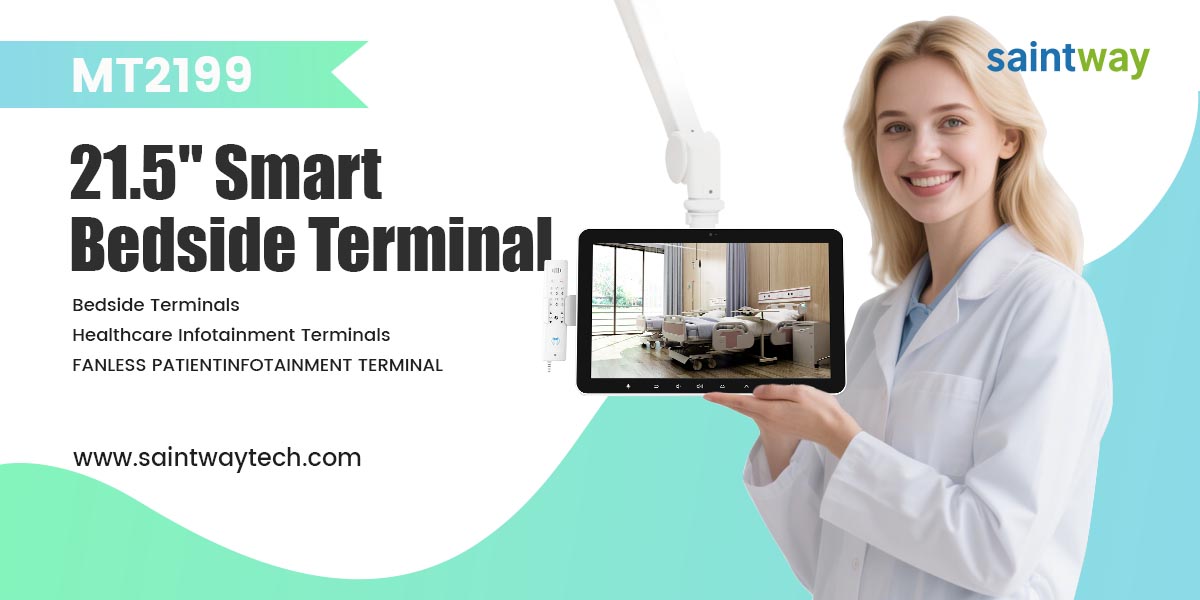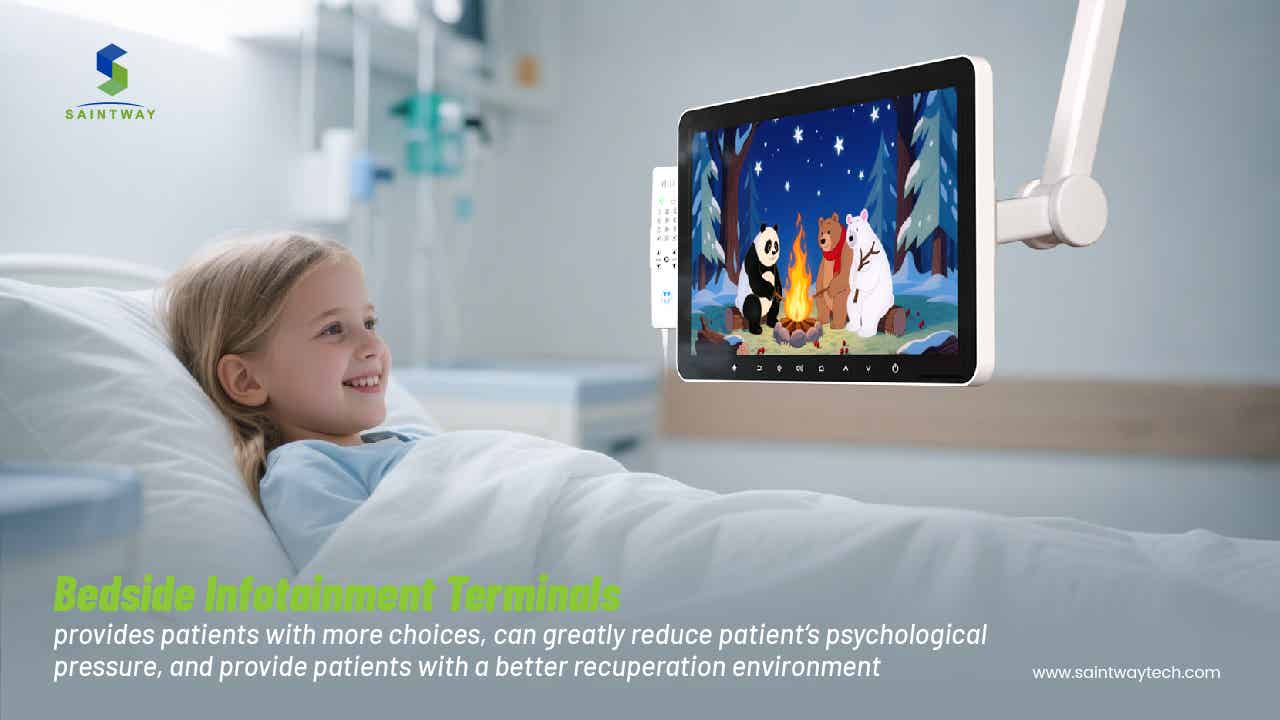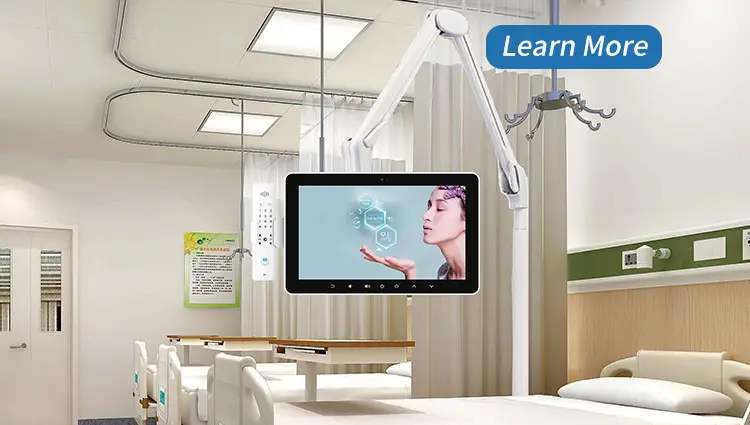- Part 1: Introduction—More Than Just a TV
- Part 2: Feature Set 1—The Clinical Core (Education & Health)
- Part 3: Feature Set 2—The Efficiency Hub (Communication & Workflow)
- Part 4: Feature Set 3—Entertainment and Comfort (The 'Infotainment' Side)
- Part 5: The CIO’s Checklist—Security, Management, and ROI
- Part 6: Going Beyond the Basics (Unique Experience & Authority)
- Part 7: Conclusion—The Future of Hospital Care is Connected
Part 1: Introduction—More Than Just a TV
1.1 What is a Patient Room Infotainment Terminal?
A patient room infotainment terminal is much more than a simple television. Think of it as a specialized, secure computer built into the patient’s bedside or wall. Its main job is to act as a digital health hub. It connects the patient to their care team, to important medical information, and to entertainment.
The term “Infotainment” combines two ideas: Information (for health and education) and Entertainment (for comfort and distraction). These terminals deliver three core benefits: They reduce patient boredom, they improve understanding of medical conditions, and they make the hospital staff’s job easier. For hospitals, this technology is a smart investment that leads to better patient outcomes and higher satisfaction scores.

1.2 Why Infotainment Matters Today (The Challenge and Solution)
Being in the hospital can be stressful and lonely. Patients often feel disconnected and anxious. The traditional hospital room—with just a basic TV—does little to help.
Modern Infotainment Terminals solve this by giving the patient control and connection. When patients are informed and engaged, they heal better. One study shows that highly engaged patients are less likely to be readmitted to the hospital. This reduces costs and proves a clear Return on Investment (ROI) for the technology.
Who Is This Guide For?
This guide is a blueprint for hospital CIOs, IT Directors, Patient Experience Managers, and Healthcare Administrators who are responsible for improving patient engagement and system efficiency.
Part 2: Feature Set 1—The Clinical Core (Education & Health)
The most valuable features of a bedside terminal are those that directly support clinical care and patient safety. These tools turn a simple screen into a powerful health companion.
2.1 On-Demand Patient Education Modules
Patients need to understand their condition and what happens after they leave the hospital. Infotainment terminals make this easy.
- Customized Content: Videos and interactive lessons on medication, discharge instructions, or physical therapy are automatically sent to the terminal based on the patient’s medical record.
- Digital Tracking: The system tracks if the patient actually watched the video. If the patient digitally signs off on the lesson, the information is automatically documented in the Electronic Health Record (EHR). This legal proof of education helps reduce readmission risk.
2.2 Seamless Electronic Health Record (EHR) Integration
The key to a high-performing terminal is its ability to talk to the hospital’s central IT systems.
- Real-Time Data Access: Patients can view their lab results, see upcoming test schedules, and check the names and photos of their care team right on the screen.
- Staff Efficiency: Nurses and doctors can securely log in to the terminal using an RFID badge or smart card. They can view X-rays, MRI images, or medical histories at the bedside without needing a heavy computer-on-wheels. This real-time charting increases documentation accuracy and saves staff time.
Question: How do patient room terminals connect to hospital EHRs?
Answer: Terminals connect using secure Application Programming Interfaces (APIs). These APIs act as digital bridges that allow the terminal to pull and push necessary data (like test results or education completion) into the main EHR system while keeping all patient data encrypted and secure.
2.3 Interactive Care Boards and Service Requests
The digital age replaces the old paper whiteboard.
- Digital Whiteboard: Displays the patient’s goals, daily schedule (medication times, therapist visits), and a photo directory of the nurses and doctors assigned that day. This clear communication builds patient trust.
- Smart Service Requests: Patients can use the terminal to send non-urgent requests directly to the right department. Need a blanket? The request goes to the aid. Need a refill of water? It goes to food service. This feature is vital for the next set of benefits.
Part 3: Feature Set 2—The Efficiency Hub (Communication & Workflow)
A major goal for any hospital CIO is to improve staff efficiency. Infotainment terminals help by streamlining communication and reducing interruptions.
3.1 Integrated Nurse Call and Smart Prioritization
The terminal is linked directly to the traditional nurse call system, but it adds intelligence.
- Direct Request Routing: When a patient uses the smart request feature (Section 2.3), it bypasses the nurse’s main urgent call panel. This means nurses are interrupted less often for non-critical needs, allowing them to focus on patients who need urgent medical attention.
- LED Indicators: Some advanced terminals include an LED light strip that changes color based on the type of call (e.g., green for a request, red for an emergency).
3.2 Virtual Visits and Telehealth Integration
This feature became essential during the last few years, but its value continues to grow.
- Video Conferencing: Patients can video chat with family and friends, helping to reduce feelings of isolation.
- Specialist Consults: Doctors can conduct virtual rounds or bring in a remote specialist for a consultation without having to physically move equipment or staff. This saves travel time and is crucial for specialties where staff is limited.
Infotainment features to reduce nurse interruptions.
The ability to use the terminal for self-service requests (like ordering a snack or adjusting the thermostat) is the single biggest feature that cuts down on unnecessary nurse call volume. This frees up nurses to focus on direct patient care.
Part 4: Feature Set 3—Entertainment and Comfort (The ‘Infotainment’ Side)
While clinical features drive safety, entertainment features drive satisfaction scores and the overall patient experience (PEx).
4.1 Personalized Entertainment Options
Distraction is a key part of pain management and recovery.
- Vast Content Library: Access to live TV, video on demand, streaming services, and a wide variety of movies and documentaries.
- Gaming and Relaxation: Interactive games and mindfulness applications (like guided meditation) are crucial for both children and long-term patients. These systems offer distraction, which can help manage pain perception.
4.2 Seamless Room Environment Controls
Giving patients control over their immediate environment helps reduce anxiety and improves comfort.
- Integrated Controls: The terminal should integrate with the room’s Internet of Things (IoT) devices. This lets the patient control the room temperature, lighting, window blinds, and bed position directly from the bedside screen or remote control.
- Device Mirroring: Patients can wirelessly share content (like photos or videos) from their personal smartphone or tablet onto the terminal screen. This brings a sense of normalcy and home comfort to the hospital room.
4.3 Accessibility and Voice Command
The best systems are designed for everyone, including patients with limited mobility or vision.
- Voice Control: Advanced terminals include voice command capability. Patients can simply say, “Turn on the light,” or “Call the nurse,” without reaching for a physical button.
- Large Print/Multilingual Support: The user interface can instantly switch to a larger text size and offer content, education, and controls in multiple languages, improving health equity.
What accessibility features do patient room terminals offer?
Answer: Key features include voice control, high-contrast display modes, large font options, and compatibility with assistive devices. This ensures patients with limited mobility or visual impairments can still fully engage with their care plan.
Part 5: The CIO’s Checklist—Security, Management, and ROI
For healthcare technology leaders, the features that matter most are security, ease of management, and financial return.
5.1 Robust Security and HIPAA Compliance
Patient data security is non-negotiable.
- Automatic Data Wipe: When a patient is discharged, the terminal must automatically and completely wipe all personal and medical data, ensuring no information is left behind for the next user.
- Secure Authentication: Clinical staff must use strong authentication methods (like RFID or smart card logins) to access the clinical side of the terminal, keeping patient information safe under HIPAA rules.
5.2 Remote Monitoring and Management (RMM)
A large hospital system cannot afford to send IT staff to every room for a simple reboot.
- Centralized Control: The entire network of terminals must be manageable from a single, remote IT dashboard.
- Automatic Updates: Software patches and updates should happen automatically and centrally, minimizing downtime and technician travel time. This operational efficiency is a hidden part of the ROI calculation.
5.3 Calculating the Real Return on Investment (ROI)
ROI for infotainment is measured in more than just money saved; it’s measured in better outcomes.
| ROI Metric | How Infotainment Terminals Help | Data Point (Expert Authority – EEAT) |
| Operational Efficiency | Reduces non-urgent nurse calls; Automates meal ordering and discharge forms. | Reduces staff workload, leading to more time for direct patient care. (Source: Vendor or Internal Case Study) |
| Financial Performance | Increases patient retention and referrals due to higher satisfaction scores. | High patient experience scores (HCAHPS) can be tied to increased Medicare reimbursement. |
| Clinical Outcomes | Ensures patients complete discharge education; Facilitates virtual consultations. | Studies show a link between high patient engagement (measured by terminal use) and a drop in readmission rates. (Source: Industry White Paper/Data needed) |

Part 6: Going Beyond the Basics (Unique Experience & Authority)
To truly lead the market, an article must cover features that competitors overlook.
6.1 Unique Content: The Power of Custom Theming
A truly unique experience can be created through intelligent interface design.
- Age-Based Interface: The terminal should display a colorful, game-focused interface for children and a professional, data-focused interface for older adults.
- Cultural Sensitivity: Offering culturally specific programming or language themes can make international patients feel significantly more comfortable and trusting. This deep personalization is where next-generation systems excel.
6.2 The Future is Now: AI-Powered Features
The newest terminals use Artificial Intelligence (AI) to improve care.
- Predictive Assistance: AI can analyze patient data (like pain scores entered into the terminal) and proactively suggest content, such as a relaxation video, before the patient needs to call a nurse for pain relief.
- Voice Assistant Integration: Voice-controlled AI assistants can manage basic requests (like turning on the TV) and allow nurses to check routine information just by speaking naturally in the room, without touching a screen.
Part 7: Conclusion—The Future of Hospital Care is Connected
Patient room infotainment terminals are no longer a luxury—they are a core part of modern healthcare infrastructure.
The best systems bring together essential clinical safety (EHR integration, education tracking), staff efficiency (smart nurse call, remote management), and patient comfort (entertainment, environment control). By investing in terminals that include the features detailed in this guide, hospitals can achieve both a superior patient experience and a measurable financial ROI.
The terminal is the central digital hub of the modern patient room, empowering patients and liberating staff to focus on what matters most: delivering high-quality care.

